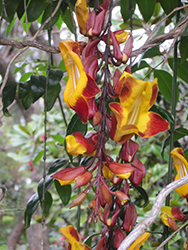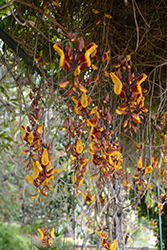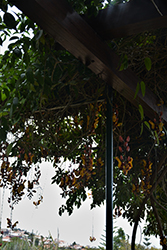Fri & Sat 8am - 8pm
Sun 8am - 7pm
Anytown, USA 12345
fax: 261.787.0463
e-mail: info@successgc.com


Plant Finder

Height: 25 feet
Spread: 3 feet
Sunlight:
![]()
![]()
Hardiness Zone: 9b
Other Names: Brick And Butter Vine, Indian Clock Vine
Description:
This evergreen, twining vine will produce exotic, red and yellow flowers all year round in mild climates; blooms dangle down from rich dark green, glossy foliage; best to train on a tall, strong structure to appreciate the hanging flowers from below
Ornamental Features
Brick & Butter Vine features showy chains of lightly-scented yellow tubular flowers with dark red overtones and brick red bracts hanging below the branches from mid winter to late fall. It has dark green evergreen foliage. The glossy oval leaves remain dark green throughout the winter. The deep purple branches are extremely showy and add significant winter interest.
Landscape Attributes
Brick & Butter Vine is a multi-stemmed evergreen woody vine with a twining and trailing habit of growth. Its average texture blends into the landscape, but can be balanced by one or two finer or coarser trees or shrubs for an effective composition.
This woody vine will require occasional maintenance and upkeep, and can be pruned at anytime. It is a good choice for attracting butterflies and hummingbirds to your yard. It has no significant negative characteristics.
Brick & Butter Vine is recommended for the following landscape applications;
- Accent
- Hedges/Screening
- General Garden Use
- Container Planting
Planting & Growing
Brick & Butter Vine will grow to be about 25 feet tall at maturity, with a spread of 3 feet. As a climbing vine, it tends to be leggy near the base and should be underplanted with low-growing facer plants. It should be planted near a fence, trellis or other landscape structure where it can be trained to grow upwards on it, or allowed to trail off a retaining wall or slope. It grows at a fast rate, and under ideal conditions can be expected to live for approximately 20 years.
This woody vine does best in full sun to partial shade. It prefers to grow in average to moist conditions, and shouldn't be allowed to dry out. It is not particular as to soil type or pH. It is somewhat tolerant of urban pollution. Consider applying a thick mulch around the root zone in winter to protect it in exposed locations or colder microclimates. This species is not originally from North America. It can be propagated by cuttings.
Brick & Butter Vine makes a fine choice for the outdoor landscape, but it is also well-suited for use in outdoor pots and containers. Because of its spreading habit of growth, it is ideally suited for use as a 'spiller' in the 'spiller-thriller-filler' container combination; plant it near the edges where it can spill gracefully over the pot. It is even sizeable enough that it can be grown alone in a suitable container. Note that when grown in a container, it may not perform exactly as indicated on the tag - this is to be expected. Also note that when growing plants in outdoor containers and baskets, they may require more frequent waterings than they would in the yard or garden.


